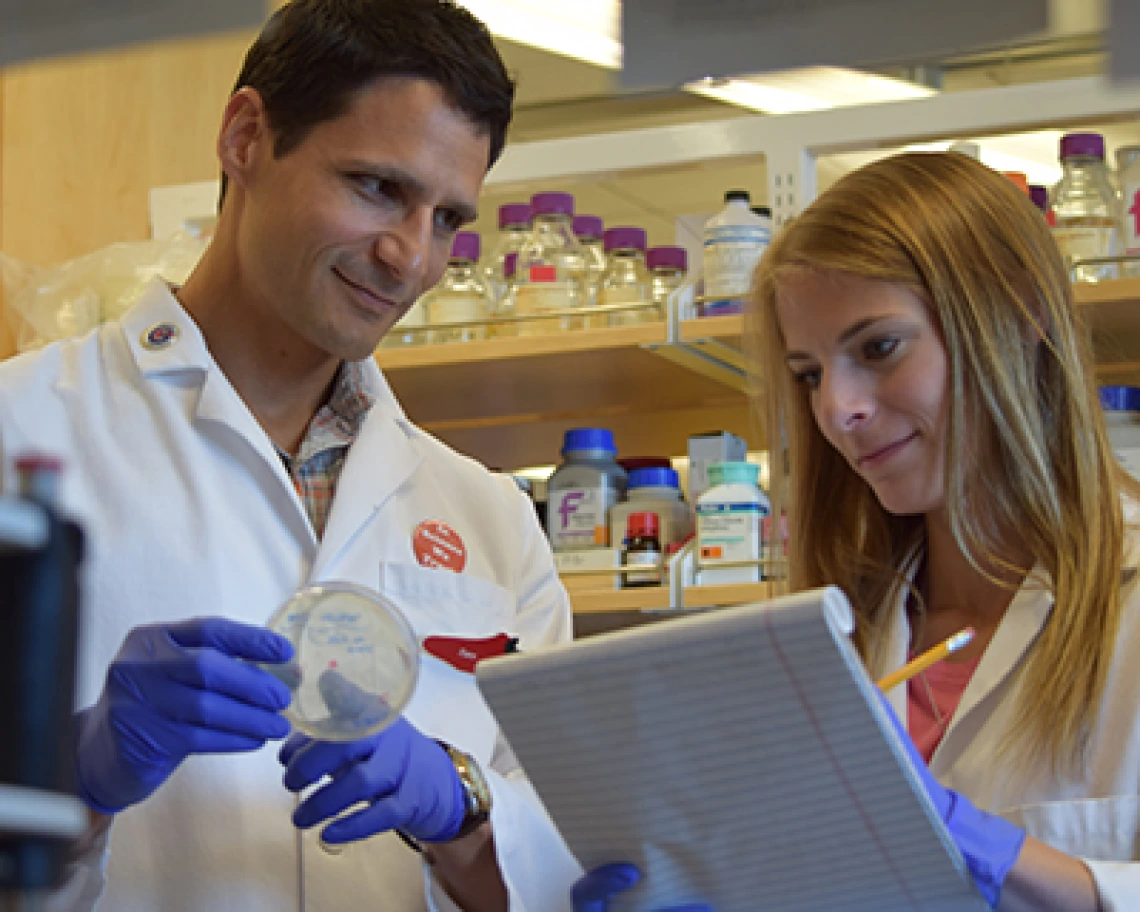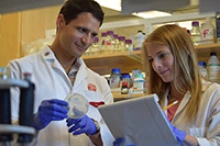UArizona Researchers Pivot to Tackle COVID-19, Splitting More Than $500,000 in Funding
Thirteen research teams will address various aspects of the COVID-19 pandemic with financial support from rapid-turnaround seed grants supplied through funding from the state and University of Arizona BIO5 Institute.

More than $500,000 has been awarded to teams of University of Arizona researchers to jump-start projects to fight COVID-19.
The university's BIO5 Institute, which connects hundreds of researchers in different disciplines to address complex challenges, was able to swiftly respond to the pandemic and release a round of seed funding via the Technology and Research Initiative Fund, which will enable researchers to positively impact the health of Arizonans and combat the global pandemic through their efforts.
Over the next six months, the researchers – BIO5 Institute members representing seven UArizona colleges – will use Technology and Research Initiative Fund (TRIF) monies to understand the lifecycle of the novel coronavirus, identify potential treatments and create patient databases to expand understanding of the disease, among other goals.

Dr. Samuel Campos (left), associate professor in the Department of Immunobiology, will work with a team of researchers to investigate how the evolutionary adaptation of a key viral structure may have enabled this novel strain to cause rapid worldwide disease. (Photo: Nicole Swinteck/Department of Immunobiology)
"Innovative faculty are working together to research how the virus spreads and infects people, developing new therapeutics and creating programs to foster health and well-being," said Jennifer Barton, PhD, director of the BIO5 Institute.
TRIF was established through Proposition 301, approved by Arizona taxpayers in November 2000 to raise the Arizona sales tax by 0.6%. Revenue generated by this mechanism is vital to supporting university research and innovation, in addition to K-12 education and community college workforce programs.
In response to the pandemic, TRIF funds were quickly allocated to create a COVID-19 seed grant program. Proposals for interdisciplinary basic science, technology, clinical or population research that directly address COVID-19 were accepted from UArizona teams of two or more researchers.
Applications were reviewed based on three criteria: the potential to make an immediate COVID-19 impact, the collaboration and teamwork of the applicants, and the use of UArizona core facilities in addressing research questions.
"In addition to funding these seed grants, TRIF support has enabled the University of Arizona to be ready to address this kind of global threat because of the research services infrastructure and core facilities that it has allowed us to build up over the last 19 years," Barton said.
Of the 55 seed grant applicants, 13 interdisciplinary groups were funded. With funds to support technical staff, postdoctoral researchers, graduate students and resources to perform analyses, researchers will address the pandemic from several angles.
Understanding the evolution of a virus
One team, representing the UArizona College of Medicine – Tucson, will investigate the evolution of the virus. Samuel Campos, associate professor of immunobiology; Scott Boitano, PhD, professor of physiology; and Ken Knox, MD, professor of medicine, will investigate how the evolutionary adaptation of a key viral structure may have enabled this novel strain to cause rapid worldwide disease.
Identifying prevention or treatment strategies for COVID-19
Curtis Thorne, PhD, assistant professor of Cellular and Molecular Medicine, and Koenraad Van Doorslaer, PhD, assistant professor in the College of Agriculture and Life Sciences, will use image-based screening techniques to identify compounds that may interfere with the ability of the virus to infect and cause long-lasting infections.

Several UArizona research teams, including one co-led by Michael Johnson, assistant professor of immunobiology, will investigate novel COVID-19 treatments. (Photo: Nicole Swinteck/Department of Immunobiology)
Equally important to preventing new infections is treating existing ones.
Two anti-malarial drugs, chloroquine and hydroxychloroquine, are currently being investigated as COVID-19 treatments, though their utility and safety is uncertain. College of Pharmacy assistant professor Jianqin Lu, PhD, BPharm, and professor Xinxin Ding, PhD, will aim to improve delivery, enhance efficacy and minimize toxicity of these drugs.
Dr. Lu also will work with Yin Chen, PhD, associate professor in the College of Pharmacy, to invetigate whether immune system activation can treat COVID-19 patients.
Another team – College of Pharmacy professor Wei Wang, PhD, and associate professors in the Department of Medicine, Steffan Nawrocki, PhD, and Jennifer Carew, PhD – will test novel inhibitors of the viral lifecycle in treating existing infections.
Epidemiological and public health approaches to the pandemic
A team representing medicine, pharmacy and the Mel and Enid Zuckerman College of Public Health will use patient data from Banner – University Medical Center Tucson and area family medicine clinics to create a local COVID-19 database. The team includes Karen Lutrick, PhD, assistant professor in the College of Medicine – Tucson; Dean Billheimer, PhD, professor of public health; and Brian Erstad, PharmD, professor in the College of Pharmacy.
A second database will be generated by researchers Kristen Pogreba-Brown, PhD, MPH, and Kate Ellingson, PhD, both assistant professors of public health, along with public health professor Elizabeth Jacobs, PhD, public health associate professor Kacey Ernst, PhD, MPH, and Pamela Garcia-Filion, PhD, MPH, associate research scientist in the Department of Biomedical Informatics at the UArizona College of Medicine – Phoenix.
Produced from patient interviews, the database will provide a catalog of risk factors and patient symptoms that can be used by all Arizona investigators addressing COVID-19.
Another epidemiological study, led by Michael Worobey, PhD, professor and head of the Department of Ecology and Evolutionary Biology, and David Baltrus, PhD, associate professor of plant sciences, aims to understand the genetics of viruses that have infected Southern Arizona patients. Through these efforts, researchers representing the College of Science and College of Agriculture and Life Sciences will seek to understand the relationship of the Arizona outbreak to the national epidemic.
Vignesh Subbian, PhD, assistant professor in the College of Engineering, will work with Jarrod Mosier, MD, associate professor in the College of Medicine – Tucson, to compile characteristics of hospitalized COVID-19 patients in Arizona.
In addition to creating databases, UArizona researchers will address public health concerns by exploring relationships between COVID-19, pre-existing health conditions and the environment.
Older adults and those with existing critical health conditions seem to be at greater risk for COVID-19. Janko Nikolich-Žugich, MD, PhD, head of the Department of Immunobiology, and associate professor Deepta Bhattacharya, PhD, will work with Craig Weinkauf, MD, PhD, assistant professor in the Department of Surgery, to find out why.
The virus has been shown to be present in the feces of infected individuals, and these live viruses can become airborne in wastewater treatment plants. A team of four researchers at the UArizona Water and Energy Sustainable Technology Center – environmental science assistant research professors Luisa Ikner and Walter Betancourt, public health professor Kelly Reynolds, PhD, MPH, and environmental science professor Ian Pepper, PhD – will work with Jeff Prevatt, deputy director of the Pima County Regional Wastewater Reclamation Department, to study the risk of the airborne virus to facility worker health.
Mental health and social isolation
COVID-19 affects more than just physical health; social isolation can increase anxiety and negatively impact mental health. Judith Gordon, PhD, professor and associate dean of research for the College of Nursing, and Chris Gniady, PhD, associate professor in the Department of Computer Science, will address the behavioral health consequences of COVID-19 through a guided imagery app.
"Together, the preliminary data collected through these TRIF-supported seed grants will not only address COVID-19 from the perspective of viral infection, prevention and treatment, but will also create resources that will prove useful in combatting this global pandemic," said Elizabeth "Betsy" Cantwell, PhD, UArizona senior vice president for research and innovation. "TRIF has allowed University of Arizona assets like the BIO5 Institute to immediately respond to critical research needs associated with grand health and environmental challenges to improve outcomes for the people of Arizona and make a difference in our world."
Additional project details are available on the BIO5 Institute website.
The UArizona Health Sciences COVID-19 Resources webpage can be found here.
For the latest on the University of Arizona response to the novel coronavirus, visit the university's COVID-19 webpage.
A version of this article appeared originally on the UANews website.
# # #
NOTE: Photos available at this link.
About the University of Arizona Health Sciences
The University of Arizona Health Sciences is the statewide leader in biomedical research and health professions training. UArizona Health Sciences includes the Colleges of Medicine (Tucson and Phoenix), Nursing, Pharmacy, and the Mel and Enid Zuckerman College of Public Health, with main campus locations in Tucson and the Phoenix Biomedical Campus in downtown Phoenix. From these vantage points, Health Sciences reaches across the state of Arizona, the greater Southwest and around the world to provide next-generation education, research and outreach. A major economic engine, Health Sciences employs nearly 5,000 people, has approximately 4,000 students and 900 faculty members, and garners $200 million in research grants and contracts annually. For more information: uahs.arizona.edu (Follow us: Facebook | Twitter | YouTube | LinkedIn | Instagram).
About the University of Arizona
The University of Arizona, a land-grant university with two independently accredited medical schools, is one of the nation's top public universities, according to U.S. News & World Report. Established in 1885, the university is widely recognized as a student-centric university and has been designated as a Hispanic Serving Institution by the U.S. Department of Education. The university ranked in the top 20 in 2018 in research expenditures among all public universities, according to the National Science Foundation, and is a leading Research 1 institution with $687 million in annual research expenditures. The university advances the frontiers of interdisciplinary scholarship and entrepreneurial partnerships as a member of the Association of American Universities, the 65 leading public and private research universities in the U.S. It benefits the state with an estimated economic impact of $4.1 billion annually.

